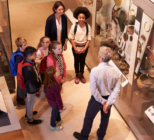One of our more interesting accounts is the work we do on the membership magazine for the Society for the Protection of Ancient Buildings (SPAB). Our scope on that particular project is to design and layout the pages and give editorial direction, subbing and proofing.
We have worked with SPAB for several years and in that time we have established ourselves and built a strong reputation in the sector. Therefore when the Institute of Conservation (ICON) was looking for a new communications partner, we were lucky enough to be recommended by the SPAB. We still had a lot of work to do and nothing was taken for granted – in fact we took part in a detailed and competitive pitch process against several other agencies.
In the end, it was our depth of approach and our clear passion for the sector that gave us the edge.
For its part, ICON set out an ambitious, interesting and far-reaching brief that was designed to bring the magazine into the 21st century. There were several under-pinning strategic aims:
1. To modernise the editorial and the design to appeal to a younger audience, without alienating the loyal and established readers.
2. To speak with a voice that unifies the many different disciplines of the profession. There are literally dozens of interest groups whose aims and interests can differ/contrast and the aim was to bring them together under one church.
3. To give a more international perspective as a large and growing percentage of the readership reside abroad.
4. There was an ambition to use the magazine as both a recruitment tool for those in the profession who weren’t yet members but also as a calling card to the general public who might have an interest in the profession.
5. Finally, the organisation wanted to raise awareness of the profession with Government and other quasi-Governmental bodies such as the Arts Council, Heritage England and The National Lottery.
As with any profession there are idiosyncrasies and commonalities which make it unique. We were keen to understand the landscape of the profession before we gave any sort of response. Therefore we researched all past communications, spoke to experts as well as the client, and our recommendations were as follows:
1. The vision was to create a clear and dynamic voice for the wider conservation profession that encompassed all disciplines. Editorial content would appeal to conservators, whatever their specialisation, through thought-leadership articles which educate and engage across a variety of fields and specialisations. We looked at the key stakeholder groups and made sure we scheduled interviews with them throughout the year in proportion to their percentage of members/influence.
2. We wanted to humanise the profession, put member voices front and centre and add depth and drama to the magazine. We added images of the authors/members to most articles and told stories in a first-person rather than third-person narrative. Furthermore, using the tone-of-voice document (see below) we introduced a more approachable and familiar voice to the writing. To bring more value, we worked on content repurposing across digital and we interviewed leading members to exemplify various disciplines.
3. We refreshed and improved the design to make it far more modern and excitingly visually, and made sure it highlights the incredible work that members do to safeguard heritage. Design emphasised the ‘wow’ by using more images across the pages and close-up details of the work being done. We have created a magazine that takes readers on a journey and is the physical manifestation of the work being done. It also serves as a recruitment tool at events, with a younger and more approachable tone.
4. We created a tone-of-voice document to ensure consistency throughout all communications by having a defined document. We also brought in new content strands to appeal to both the experienced and the novice conservator.
5. We created a 12-month editorial document which had the overall strategic aims at the top of the funnel but then broke this down so that we ensured even and fair coverage for all of the interest groups, topics, values and so on. This is monitored on an ongoing basis to ensure every article is linked back to the aims of the initial document and is presented to the client quarterly for feedback.
Oh and finally, we even changed the name of the magazine from ‘Icon news’ to ‘Iconnect’ which has a nice double meaning and promotes this idea of the organisation connecting with members more.
What we have ended up with is a magazine that exceeds the expectations of the client and delivers a product that you wouldn’t expect from a small heritage organisation with a limited budget. The latest cover featuring the Trump blimp exemplifies this perfectly.
The reason for this is a clear brief at the start, diligence at both ends of the equation, passion and collaboration between the client and us, their provider.
Get in touch if you’d like to discuss how we can improve your member communications.
Steward Dymock – [email protected] 01727 739194






